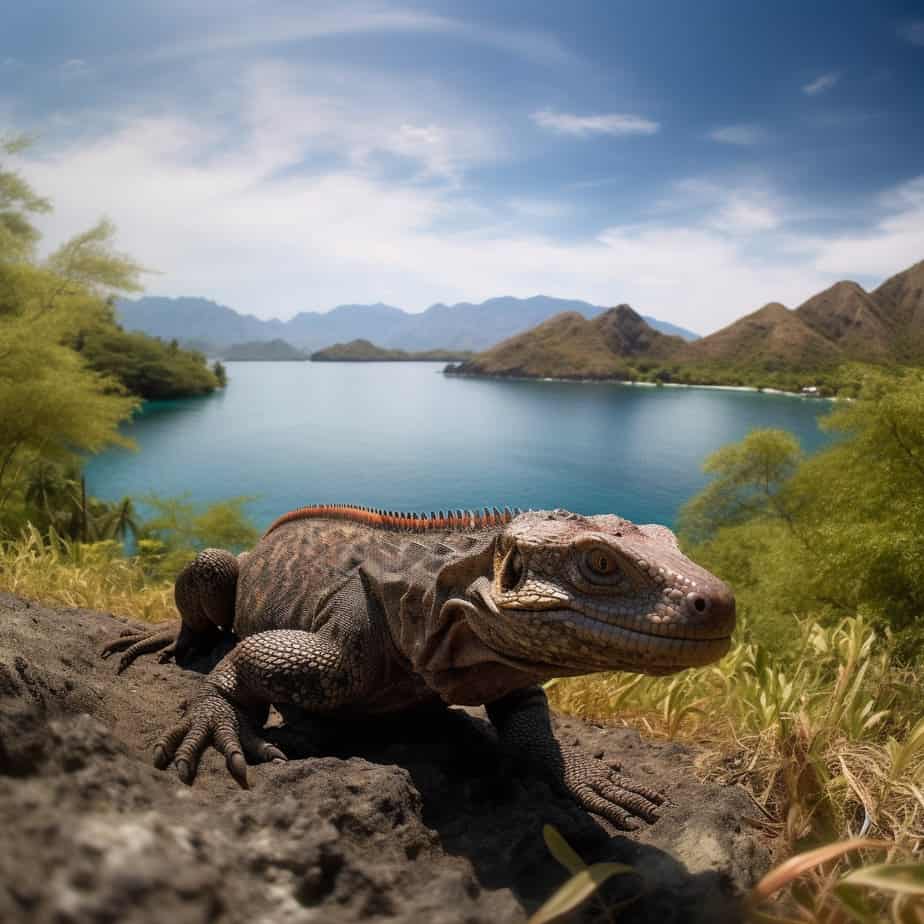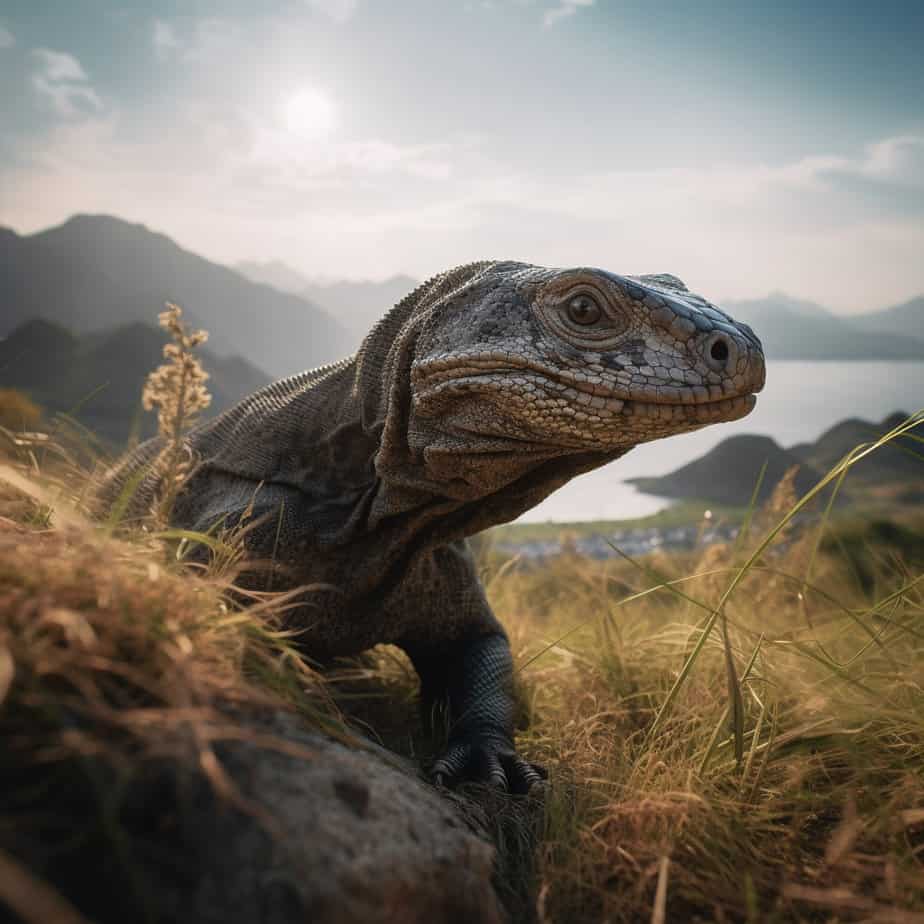The Komodo dragon and the python are two fascinating creatures that inhabit different parts of the world. The Komodo dragon, also known as Varanus komodoensis, is a large lizard found in the Indonesian islands of Komodo, Rinca, Flores, and Gili Motang. On the other hand, the python is a non-venomous snake that can be found in various regions across the globe, including Southeast Asia, Africa, and Australia. While both animals are formidable predators in their own right, they have distinct characteristics and hunting strategies that set them apart. In this article, we will explore the unique features and behaviors of the Komodo dragon and the python, and delve into the intriguing question of how they would fare in a hypothetical encounter. So, let’s dive into the world of these incredible creatures and compare the Komodo dragon and the python in a head-to-head battle.
Key Takeaways
- Komodo dragons are the largest lizards in the world, while pythons are among the largest snakes.
- Komodo dragons have a venomous bite, while pythons kill their prey by constriction.
- Komodo dragons are native to Indonesia, while pythons can be found in various parts of the world.
- Both species are formidable predators and play important roles in their respective ecosystems.
Understanding the Combatants: Komodo Dragon and Python
A. The Komodo Dragon: A Brief Overview
The Komodo dragon, scientifically known as Varanus komodoensis, is a fascinating reptile that inhabits the islands of Indonesia. It is the largest lizard species in the world, with some individuals reaching lengths of up to 10 feet and weighing around 150 pounds. These powerful predators have captured the imagination of people around the globe.
1. Habitat and Distribution
Komodo dragons are native to the islands of Komodo, Rinca, Flores, Gili Motang, and Padar. These islands are part of the Indonesian archipelago and provide the perfect habitat for these majestic creatures. The warm and tropical climate, combined with the diverse range of prey, allows the Komodo dragon to thrive in this region.
2. Physical Characteristics
The Komodo dragon has several unique physical characteristics that make it a formidable predator. Its muscular body is covered in rough, scaly skin, which provides protection from its environment. Their powerful legs and sharp claws enable them to move swiftly and capture their prey. Additionally, their long, forked tongues help them detect the scent of potential meals.
3. Diet and Hunting Behavior
Komodo dragons are carnivorous and have a varied diet. They primarily feed on carrion, but they are also skilled hunters. Their diet consists of small mammals, birds, and reptiles. They have even been known to take down larger prey, such as water buffalo and deer. Komodo dragons use their strong jaws and serrated teeth to tear apart their meals, and their saliva contains bacteria that can cause infections in their prey, leading to a slow and painful death.
B. The Reticulated Python: A Quick Look
The reticulated python, scientifically known as Python reticulatus, is one of the largest snake species in the world. It is found in Southeast Asia and is known for its impressive size and strength. Let’s take a closer look at this incredible reptile.
1. Habitat and Distribution
Reticulated pythons are found in a wide range of habitats, including rainforests, grasslands, and swamps. They are native to Southeast Asia, including countries like Indonesia, Malaysia, and the Philippines. These snakes are excellent swimmers and are often found near bodies of water.
2. Physical Characteristics
The reticulated python is known for its distinctive pattern of dark brown or black markings on a lighter background. These markings help camouflage the snake in its natural environment. They have a slender body, which allows them to move swiftly through the undergrowth. Reticulated pythons can grow to impressive lengths, with some individuals reaching over 20 feet long.
3. Diet and Hunting Behavior
Reticulated pythons are constrictors, meaning they squeeze their prey to subdue and kill it. They have a remarkable ability to stretch their jaws and swallow prey much larger than their own head. Their diet consists mainly of mammals, such as rodents, monkeys, and deer. After capturing their prey, reticulated pythons use their powerful muscles to constrict and suffocate it before swallowing it whole.
In conclusion, both the Komodo dragon and the reticulated python are fascinating creatures with unique characteristics that make them formidable predators in their respective habitats. While the Komodo dragon relies on its powerful jaws and venomous saliva to bring down its prey, the reticulated python uses its strength and constricting abilities to overpower its victims. These reptiles serve as a reminder of the incredible diversity and adaptability of the animal kingdom.
Physical Attributes: A Comparative Analysis
A. Size and Weight: Komodo Dragon vs Python
When it comes to size and weight, both the Komodo dragon and the python are impressive creatures in their own right. However, there are significant differences between the two.
The Komodo dragon, known as the largest lizard species in the world, can grow up to an astonishing length of 10 feet and weigh around 150 pounds. These massive reptiles are native to the Indonesian islands and are often found in the wild. In captivity, they can live up to 20 years.
On the other hand, the python, a constrictor snake, can reach even greater lengths. Some species of pythons, such as the reticulated python, can grow up to a staggering 23 feet long. However, they are generally lighter than the Komodo dragon, with an average weight of around 100 pounds. Pythons have a longer lifespan compared to Komodo dragons, with some individuals living up to 30 years.
B. Strength and Speed: The Battle of the Giants
In terms of strength and speed, both the Komodo dragon and the python possess unique abilities that make them formidable predators in their respective habitats.
The Komodo dragon, with its muscular build and powerful jaws, is known for its incredible bite force. It can deliver a devastating bite that can incapacitate its prey, which includes deer, pigs, and even water buffalo. Despite their large size, Komodo dragons are surprisingly agile and can reach speeds of up to 12 miles per hour in short bursts.
On the other hand, the python relies on its incredible strength and constriction abilities to overpower its prey. These snakes have a unique adaptation that allows them to dislocate their jaws, enabling them to swallow prey much larger than their own head. Once the python captures its prey, it coils around it and constricts, suffocating the victim before swallowing it whole. This method of hunting requires immense strength and patience.
While the Komodo dragon relies on its bite force and agility, the python’s strength and constriction abilities give it an advantage in close-quarters combat. However, it’s important to note that these two species inhabit different environments and have evolved different survival tactics to suit their needs.
In conclusion, the Komodo dragon and the python are both impressive creatures with unique physical attributes. The Komodo dragon’s size and bite force make it a formidable predator, while the python’s strength and constriction abilities allow it to overpower its prey. Understanding the characteristics of these reptiles helps us appreciate the diversity and adaptability of the natural world.
Hunting Strategies: How They Attack

When it comes to hunting, both the Komodo dragon and the python have developed unique strategies to capture their prey. Let’s take a closer look at how these two formidable predators attack their victims.
A. The Deadly Bite: Komodo Dragon’s Secret Weapon
The Komodo dragon, known as the largest lizard species in the world, has a fearsome reputation for its deadly bite. With its powerful jaws and sharp teeth, the Komodo dragon can deliver a devastating blow to its prey.
When hunting, the Komodo dragon relies on its keen sense of smell to locate potential targets. Once it has detected a scent, it stealthily approaches its prey, using its strong legs and muscular tail to move swiftly through its natural habitat in Indonesia.
When the Komodo dragon gets within striking distance, it launches itself towards its victim, delivering a powerful bite. Its saliva contains a mix of venom and bacteria that can cause severe infections. This venomous bite weakens the prey, making it easier for the Komodo dragon to overpower and ultimately kill its victim.
The Komodo dragon’s bite is not only deadly but also strategic. After delivering the initial blow, it patiently waits for its prey to weaken from the venomous effects. Once the prey is immobilized, the Komodo dragon moves in for the final kill.
B. The Power of Constriction: Python’s Mode of Attack
In contrast to the Komodo dragon’s bite, the python relies on a different method of attack: constriction. As a constrictor snake, the python uses its powerful body to squeeze the life out of its prey.
When hunting, the python relies on its excellent camouflage and ambush tactics. It patiently waits for its prey to come within striking distance, often hiding in vegetation or burrows. Once the python spots its target, it swiftly moves in for the kill.
Using its muscular body, the python wraps itself around its prey, constricting it with incredible force. This constriction cuts off the prey’s blood circulation and prevents it from breathing, leading to a slow and suffocating death. The python‘s ability to constrict its victims allows it to overpower prey that is often much larger than itself.
While the Komodo dragon relies on its venomous bite to weaken its prey, the python’s constriction technique ensures a swift and efficient kill. This mode of attack is particularly effective against animals that rely on their agility and speed to escape predators.
In conclusion, both the Komodo dragon and the python have developed unique hunting strategies to secure their meals. While the Komodo dragon uses its deadly bite and venom to immobilize its prey, the python relies on its powerful constriction to overpower its victims. These distinct hunting techniques highlight the adaptability and survival skills of these remarkable reptiles.
Defense Mechanisms: Survival Tactics

A. Komodo Dragon’s Defensive Strategies
The Komodo dragon, a formidable predator, possesses a range of defense mechanisms that enable it to survive in its natural habitat. These strategies have evolved over millions of years, allowing the Komodo dragon to thrive in the harsh and competitive environment it calls home.
-
Camouflage: One of the Komodo dragon’s primary defensive tactics is its ability to blend into its surroundings. With its rough, scaly skin and earthy colors, the Komodo dragon can easily conceal itself among the dense vegetation of its Indonesian habitat. This camouflage helps it remain undetected by potential threats and allows it to surprise unsuspecting prey.
-
Powerful Bite: The Komodo dragon’s most fearsome weapon is its powerful bite. Equipped with sharp, serrated teeth, the dragon can deliver a devastating blow to its adversaries. Its bite is not only capable of inflicting severe injuries, but it also carries a deadly cocktail of bacteria that can cause infections in its prey. This unique adaptation allows the Komodo dragon to weaken its victims over time, making them easier to overpower.
-
Venomous Saliva: Contrary to popular belief, the Komodo dragon is not venomous. However, recent studies have revealed that its saliva contains a potent mix of bacteria that can cause blood poisoning. When the dragon bites its prey, these bacteria enter the wound and gradually weaken the victim. This venom-like effect further enhances the Komodo dragon’s ability to subdue larger animals.
-
Tail Lashing: When confronted by a potential threat, the Komodo dragon may resort to using its muscular tail as a defensive tool. With a single swipe, it can deliver a forceful blow, capable of stunning or even injuring its attacker. This tail lashing technique is often used as a last resort when the dragon feels cornered or threatened.
B. Python’s Countermeasures
In the reptilian world, the python is renowned for its unique set of survival tactics. As a constrictor snake, it relies on its physical strength and stealth to overpower its prey and defend itself against potential threats.
-
Camouflage: Similar to the Komodo dragon, the python relies on camouflage to remain hidden from predators and prey alike. With its intricate pattern and coloration, the python can blend seamlessly into its surroundings, making it difficult to spot. This ability allows the snake to surprise its prey and evade potential dangers.
-
Constriction: The python‘s most well-known defense mechanism is its ability to constrict its prey. Once the python has successfully captured its victim, it wraps its muscular body around it, squeezing tightly until the prey suffocates. This method not only allows the python to subdue larger animals but also serves as a means of defense against potential threats. By constricting its attacker, the python can immobilize and potentially injure them, giving it the opportunity to escape.
-
Warning Signs: When threatened, the python may display a series of warning signs to deter potential predators. It may hiss loudly, exposing its fangs and inflating its body to appear larger and more intimidating. This display is often enough to discourage would-be attackers, as the python’s size and strength can be quite formidable.
-
Retreat: If all else fails, the python will resort to retreating as a means of self-preservation. Due to their ability to move silently and swiftly, pythons can quickly disappear into the surrounding vegetation, making it difficult for predators to track them. This retreat allows the python to avoid unnecessary confrontations and ensures its survival in the wild.
In the battle between the Komodo dragon and the python, both species have developed unique defense mechanisms that enable them to survive and thrive in their respective habitats. While the Komodo dragon relies on its powerful bite and venomous saliva, the python utilizes its strength and constricting abilities. These survival tactics highlight the incredible adaptability and resilience of these large reptile species.
Hypothetical Combat: Komodo Dragon vs Python Fight

A. Setting the Stage: The Battle Ground
In the wilds of Indonesia, two formidable predators roam the land: the Komodo dragon and the python snake. These large reptile species have captivated the imagination of wildlife enthusiasts and researchers alike. While they inhabit different habitats and possess distinct characteristics, it’s intriguing to ponder what would happen if these two powerful creatures were to engage in a battle.
The Komodo dragon, known scientifically as Varanus komodoensis, is native to the Indonesian islands of Komodo, Rinca, Flores, Gili Motang, and Padar. This fearsome lizard can grow up to 10 feet in length and is a skilled predator. With its powerful jaws and sharp teeth, the Komodo dragon can take down prey as large as a water buffalo. Its saliva contains a potent mix of bacteria that can cause septicemia, weakening and eventually killing its victims.
On the other hand, we have the python, a constrictor snake known for its ability to overpower and suffocate its prey. Pythons can be found in various parts of the world, including Southeast Asia, Africa, and Australia. These snakes have a flexible bone structure that allows them to swallow prey whole, even if it is larger than their own body size. With their muscular bodies, pythons can constrict their victims, squeezing the life out of them.
B. Round One: Initial Encounter
In this hypothetical battle, let’s imagine that a Komodo dragon and a python come face to face in the dense jungles of Indonesia. The encounter begins with both predators sensing each other’s presence. The Komodo dragon, with its acute sense of smell, detects the python’s scent in the air. Meanwhile, the python, with its heat-sensing pits, picks up the Komodo dragon’s body heat.
As the two predators lock eyes, a tense standoff ensues. The Komodo dragon, known for its aggressive behavior, may attempt to intimidate the python by inflating its throat and hissing loudly. The python, being a more stealthy creature, might coil its body and remain motionless, waiting for the perfect moment to strike.
C. Round Two: Escalation of the Fight
As the battle escalates, the Komodo dragon makes the first move. With lightning-fast speed, it lunges towards the python, jaws wide open, aiming to deliver a powerful bite. However, the python’s quick reflexes allow it to evade the attack, slithering away just in time.
Realizing that it cannot rely solely on its bite, the Komodo dragon resorts to its secondary weapon: its long, muscular tail. With a swift flick, it attempts to whip the python, hoping to immobilize it. But the python, with its agility and flexibility, manages to dodge the attack once again.
D. Final Round: The Decisive Moment
As the battle reaches its climax, both predators are determined to claim victory. The Komodo dragon, frustrated by its failed attempts, decides to change tactics. It uses its powerful legs to charge at the python, attempting to pin it to the ground. However, the python’s strength lies in its ability to constrict its prey, and it quickly wraps its muscular body around the Komodo dragon, squeezing it with all its might.
The Komodo dragon, with its tough scales and thick skin, proves to be a formidable opponent. It thrashes and tries to break free from the python’s grip. But the python’s constriction is relentless, gradually weakening the Komodo dragon.
In the end, it is the python’s suffocating grip that determines the outcome of this hypothetical battle. With its superior strength and deadly technique, the python emerges victorious, overpowering the Komodo dragon.
While this hypothetical scenario may never play out in reality, it highlights the unique characteristics and survival tactics of these two remarkable reptiles. Both the Komodo dragon and the python have evolved to thrive in their respective habitats, showcasing the wonders of nature’s diversity.
Factors Influencing the Outcome: Who Would Win?
When it comes to a hypothetical battle between a Komodo dragon and a python, several factors come into play that can influence the outcome. Let’s explore these factors and understand how they contribute to the potential victor.
A. Role of Size and Strength
Size and strength play a crucial role in determining the outcome of a confrontation between a Komodo dragon and a python. The Komodo dragon, native to the Indonesian islands, is the largest lizard species in the world. It can grow up to 10 feet in length and weigh around 150 pounds. On the other hand, pythons are among the largest snake species, capable of reaching lengths of over 20 feet and weighing up to 200 pounds.
In terms of sheer size, the python has the advantage. However, the Komodo dragon possesses immense strength, which it utilizes to overpower its prey. With powerful limbs and a muscular body, the dragon can deliver bone-crushing bites and exert significant force. Conversely, pythons rely on constriction to subdue their prey. They coil around their victims, squeezing tightly until their prey succumbs to asphyxiation.
B. Impact of Hunting Strategies
The hunting strategies employed by the Komodo dragon and the python also contribute to the potential outcome of a battle. Komodo dragons are opportunistic hunters, relying on their excellent sense of smell to locate carrion or weakened prey. They have been known to ambush their victims, using their powerful jaws and sharp teeth to deliver a lethal bite. Additionally, the Komodo dragon’s saliva contains a potent mix of bacteria, which can cause infections in its prey, leading to a slow and painful death.
On the other hand, pythons are stealthy predators. They patiently lie in wait for their prey, using their excellent camouflage to blend into their surroundings. Once an unsuspecting animal comes within striking distance, the python strikes with lightning speed, coiling around its victim and initiating the constriction process. This hunting technique allows the python to overpower prey that may be larger than itself.
C. Importance of Defense Mechanisms
Both the Komodo dragon and the python possess defense mechanisms that aid in their survival. The Komodo dragon’s primary defense mechanism is its venomous bite. While not lethal to humans, the dragon’s bite can cause severe injury and infection. This venom serves two purposes: it weakens the prey, making it easier for the dragon to overpower, and it prevents the prey from escaping, as the venom induces paralysis.
On the other hand, the python relies on its physical attributes for defense. Its large size, muscular body, and ability to constrict make it a formidable opponent. When threatened, pythons can strike with surprising speed, using their sharp teeth to inflict wounds. Additionally, their ability to coil tightly around their bodies makes it difficult for predators to penetrate their defenses.
In conclusion, a battle between a Komodo dragon and a python would be a clash of two powerful and unique predators. While the python’s size and constriction abilities give it an advantage, the Komodo dragon’s strength, venomous bite, and hunting strategies make it a formidable opponent. Ultimately, the outcome of such a confrontation would depend on various factors, including the size and strength of the individuals involved, their hunting techniques, and their defense mechanisms.
Can a Komodo Dragon Kill a Python?
A. Evaluating the Possibility
When it comes to the battle between a Komodo dragon and a python, it’s natural to wonder who would come out on top. Both of these creatures are formidable predators in their own right, each with its own unique set of skills and adaptations. Let’s take a closer look at the characteristics of these reptiles and evaluate the possibility of a Komodo dragon killing a python.
Komodo Dragon Characteristics
The Komodo dragon, also known as Varanus komodoensis, is a large reptile species native to the Indonesian islands of Komodo, Rinca, Flores, Gili Motang, and Padar. It is the largest living lizard, with males reaching lengths of up to 10 feet and weighing around 150 pounds. These powerful creatures have a muscular build and are known for their sharp teeth and claws.
Python Snake Features
On the other hand, the python is a constrictor snake found in various parts of the world, including Africa, Asia, and Australia. There are several species of pythons, with the reticulated python being one of the largest. These snakes can grow to impressive lengths, with some individuals exceeding 20 feet. Pythons have a slender body and are known for their ability to squeeze and suffocate their prey.
Reptile Comparison
In terms of size, the Komodo dragon has the advantage over the python. However, the python compensates for its smaller size with its constricting abilities. While the Komodo dragon relies on its powerful bite and venomous saliva to incapacitate its prey, the python uses its muscular body to wrap around its victim and squeeze the life out of it.
B. Historical and Anecdotal Evidence
To determine whether a Komodo dragon can kill a python, we can look at historical and anecdotal evidence of reptile confrontations. While there are no documented instances of a Komodo dragon specifically targeting and killing a python in the wild, both species have been observed preying on similar types of animals.
Komodo Dragon Diet
Komodo dragons are opportunistic hunters and scavengers. They primarily feed on a variety of prey, including deer, pigs, water buffalo, and smaller reptiles. Their powerful jaws and serrated teeth allow them to tear through flesh and consume large chunks of meat. However, it’s worth noting that pythons are not a typical part of the Komodo dragon’s diet.
Python Diet
Pythons, on the other hand, have a more diverse diet. They are known to prey on a wide range of animals, including small mammals, birds, and reptiles. While they are capable of taking down larger prey, such as deer or antelope, they generally target smaller animals that they can overpower and swallow whole.
Reptile Survival Tactics
In a hypothetical encounter between a Komodo dragon and a python, both reptiles would likely employ their respective survival tactics. The Komodo dragon would rely on its powerful bite and venomous saliva to incapacitate the python, while the python would attempt to constrict the dragon and cut off its blood circulation.
Reptile Combat
Given the size and strength advantage of the Komodo dragon, it is possible that it could overpower a python in a direct confrontation. However, the outcome would depend on various factors, such as the size and health of the individuals involved, as well as the element of surprise and the environment in which the encounter takes place.
In conclusion, while there is no definitive evidence of a Komodo dragon killing a python, it is possible that a Komodo dragon could overpower a python in a direct confrontation. However, it’s important to remember that in the wild, these reptiles have evolved to target different types of prey and have their own unique hunting strategies. Conclusion
In conclusion, the battle between the Komodo dragon and the python is a fascinating clash of two formidable predators. Both creatures possess unique characteristics and strategies that enable them to survive and thrive in their respective habitats. The Komodo dragon, with its powerful bite and venomous saliva, is a skilled hunter that can take down large prey. On the other hand, the python relies on its incredible strength, constriction abilities, and ambush tactics to overpower its victims. While the Komodo dragon has the advantage of size and venom, the python’s agility and adaptability make it a formidable opponent. Ultimately, the outcome of a confrontation between these two creatures would depend on various factors such as size, age, and individual strengths. Nonetheless, it is undeniable that both the Komodo dragon and the python are awe-inspiring creatures that have earned their place as apex predators in their respective ecosystems.
Frequently Asked Questions
Q1: What is the difference between a Komodo dragon and a reticulated python?
A: Komodo dragons and reticulated pythons are both large reptile species but they have different characteristics and habitats. Komodo dragons are venomous predators native to Indonesia, known for their robust size and aggressive behavior. They have a diet primarily consisting of carrion but they can also hunt and kill prey. Reticulated pythons, on the other hand, are constrictors found in Southeast Asia. They are the world’s longest snakes and among the three heaviest. Their diet mainly consists of mammals and birds.
Q2: Can a Komodo dragon kill a python?
A: Yes, a Komodo dragon can potentially kill a python. Komodo dragons have venomous bites and are known for their aggressive behavior and strength. However, the outcome of such a confrontation would depend on various factors including the size, age, and health of both creatures.
Q3: Who would win in a fight between a Komodo dragon and a python?
A: It’s hard to definitively say who would win in a fight between a Komodo dragon and a python as it would depend on various factors. However, Komodo dragons are venomous and have strong, sharp claws, while pythons are constrictors that can suffocate their prey. Both have their unique survival tactics and strengths.
Q4: What are the key characteristics of a Komodo dragon?
A: Komodo dragons are the largest living lizards in the world. They can grow up to 10 feet in length and weigh up to 200 pounds. They have a robust body, a long, flat head with a rounded snout, scaly skin, bowed legs, and a large, muscular tail. They are also venomous predators.
Q5: What are the main features of a python?
A: Pythons are one of the largest snakes in the world. They can grow up to 33 feet long and are known for their constricting ability. They have a carnivorous diet, primarily eating mammals and birds. They are non-venomous but have sharp, backward-curving teeth.
Q6: What is the habitat of a Komodo dragon?
A: Komodo dragons are native to Indonesia, specifically the islands of Komodo, Rinca, Flores, and Gili Motang. They prefer hot and dry places and typically live in dry, open grassland, savanna, and tropical forest at low elevations.
Q7: What is the habitat of a python?
A: Pythons are found in a variety of habitats across Africa, Asia, and Australia. They prefer warm, wet climates and are often found in rainforests, savannas, and deserts. Some species also live near water and are excellent swimmers.
Q8: What is the lifespan of a Komodo dragon?
A: Komodo dragons can live up to 30 years in the wild, although their lifespan can be longer in captivity due to the absence of predators and availability of regular meals.
Q9: What is the lifespan of a python?
A: The lifespan of a python varies depending on the species, but on average, they can live between 15 to 30 years in the wild. In captivity, with proper care, they can live up to 40 years.
Q10: What are the survival tactics of a Komodo dragon and a python?
A: Komodo dragons use their venomous bite, strength, and aggressive behavior as survival tactics. They are also known for their ability to consume large amounts of food at once, which allows them to go for several weeks without eating. Pythons, on the other hand, use constriction to kill their prey. They are ambush predators, lying in wait for the perfect moment to strike. They also have the ability to survive without food for extended periods.




